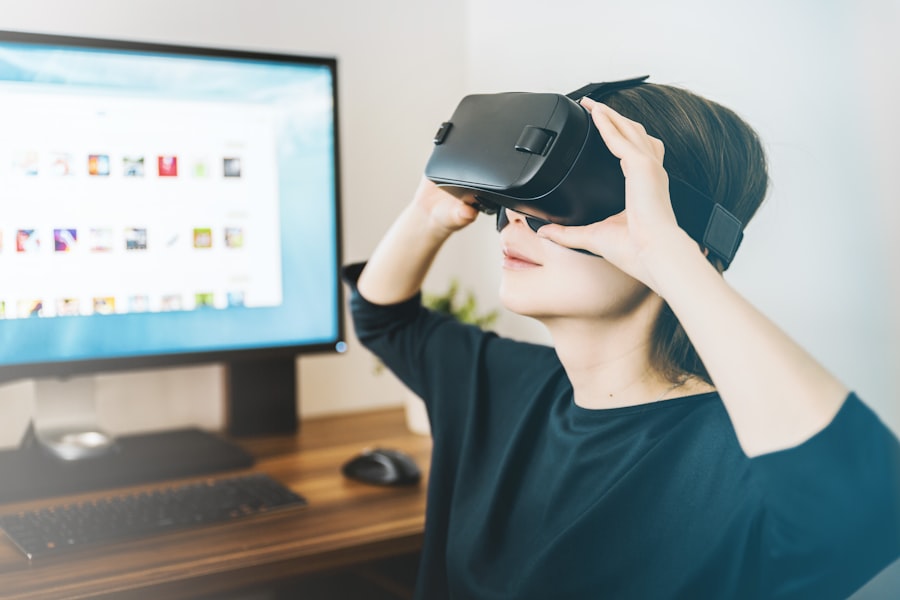Download links
How to install Exploring the Virtual Life: A Journey into Digital Realms APK?
1. Tap the downloaded Exploring the Virtual Life: A Journey into Digital Realms APK file.
2. Touch install.
3. Follow the steps on the screen.
Description
The emergence of virtual worlds can be traced back to the early days of the internet, where text-based environments like MUD (Multi-User Dungeon) allowed users to interact in a shared digital space. However, the true explosion of virtual worlds began in the early 2000s with the advent of more sophisticated graphical interfaces and expansive online environments. Games such as “Second Life” and “World of Warcraft” not only provided immersive experiences but also fostered communities that transcended geographical boundaries.
These platforms allowed users to create avatars, engage in social interactions, and even build their own virtual properties, marking a significant shift in how people perceived online interaction. As technology advanced, so did the complexity and realism of these virtual worlds. The introduction of high-speed internet and powerful graphics processing units enabled developers to create richly detailed environments that could host thousands of players simultaneously.
This evolution was further accelerated by the rise of social media, which encouraged users to share their experiences and connect with others in these digital realms. The concept of virtual reality (VR) began to take shape, with companies investing heavily in hardware and software that would allow for even more immersive experiences. The combination of these factors has led to a burgeoning industry that continues to grow, attracting millions of users who seek not just entertainment but also social connection and creative expression.
Key Takeaways
- Virtual worlds are becoming increasingly popular, offering new opportunities for social interaction and entertainment.
- Navigating the digital landscape requires a balance between online and offline activities to maintain a healthy lifestyle.
- Building relationships in the virtual realm can be just as meaningful and impactful as in the physical world.
- Virtual economies and marketplaces offer unique opportunities for entrepreneurship and financial growth.
- The impact of virtual life on mental health is a growing concern, requiring further research and support for users.
Navigating the Digital Landscape
Navigating the digital landscape of virtual worlds requires a unique set of skills and an understanding of the various platforms available. Each virtual environment offers distinct features, rules, and cultures that can significantly influence user experience. For instance, in “Minecraft,” players can build and explore vast landscapes, while “Fortnite” emphasizes competitive gameplay and social interaction through its battle royale format.
Understanding these nuances is crucial for users who wish to fully engage with the communities and activities within these spaces. Moreover, the digital landscape is constantly evolving, with new technologies and trends emerging regularly. The rise of augmented reality (AR) applications, such as “Pokémon GO,” has blurred the lines between physical and virtual spaces, creating hybrid experiences that challenge traditional notions of navigation.
Users must adapt to these changes, learning how to leverage new tools and platforms to enhance their interactions. This adaptability is essential not only for personal enjoyment but also for professional opportunities, as many industries begin to recognize the potential of virtual environments for training, marketing, and collaboration.
Building Relationships in the Virtual Realm

The ability to forge meaningful relationships in virtual worlds is one of their most compelling aspects. Players can collaborate on projects, participate in events, or simply spend time together in a way that fosters camaraderie. For example, in “World of Warcraft,” guilds serve as social structures where players can form friendships based on shared goals and achievements, creating a sense of belonging that transcends the game itself.
However, building relationships in these digital spaces is not without its challenges. The anonymity afforded by avatars can lead to both positive and negative interactions. This duality necessitates a level of emotional intelligence and social awareness that is crucial for navigating these complex dynamics.
(Source: Psychology Today)
Exploring Virtual Economies and Marketplaces
| Metrics | Data |
|---|---|
| Number of virtual economies | 20 |
| Marketplace size | 10 billion USD |
| Number of virtual goods traded | 100 million |
| Virtual currency exchange rate | 1 USD = 100 virtual credits |
Virtual economies have emerged as a fascinating aspect of life within digital worlds, often mirroring real-world economic principles while introducing unique elements specific to their environments. In many virtual spaces, users can create, buy, sell, and trade virtual goods and services, leading to the development of intricate marketplaces. For instance, “Second Life” features a robust economy where users can purchase land, design clothing, or even offer services like virtual real estate management.
This economy operates on its own currency, the Linden Dollar, which can be exchanged for real-world money, blurring the lines between virtual and physical wealth. The rise of non-fungible tokens (NFTs) has further transformed virtual economies by allowing users to own unique digital assets that can be bought and sold across various platforms. Artists and creators have found new avenues for monetization through NFTs, enabling them to sell their work directly to consumers without intermediaries.
This shift has not only empowered creators but has also sparked debates about ownership, copyright, and the value of digital art. As virtual economies continue to evolve, they present both opportunities and challenges for users seeking to navigate this new financial landscape.
The Impact of Virtual Life on Mental Health
The intersection of virtual life and mental health is a complex topic that has garnered increasing attention from researchers and mental health professionals alike. On one hand, virtual worlds can provide a sense of community and belonging for individuals who may struggle with social anxiety or isolation in the real world. Engaging in these environments allows users to connect with others who share similar interests or experiences, fostering support networks that can be beneficial for mental well-being.
For example, individuals with disabilities may find it easier to interact in virtual spaces where physical limitations are less pronounced. Conversely, excessive engagement in virtual worlds can lead to negative mental health outcomes. The immersive nature of these environments can result in escapism, where individuals may choose to withdraw from real-life responsibilities or relationships in favor of their digital lives.
This phenomenon can exacerbate feelings of loneliness or depression when users find it difficult to balance their online interactions with offline realities. Additionally, exposure to toxic behavior or cyberbullying within these spaces can contribute to anxiety and stress. As such, it is essential for users to cultivate a healthy relationship with virtual worlds, recognizing when their engagement may be crossing into unhealthy territory.
The Future of Virtual Reality and its Role in Society

New Frontiers in Education, Healthcare, and Remote Work
This evolution could lead to new applications in fields such as education, healthcare, and remote work, where VR can facilitate training simulations or collaborative projects across distances. Moreover, as society becomes more accustomed to virtual interactions, we may see a shift in cultural norms surrounding communication and connection. The ability to attend events or socialize in virtual spaces could redefine how we perceive community and relationships.
Ethical Considerations and Challenges
However, this shift also raises important ethical considerations regarding privacy, data security, and the potential for addiction. As we navigate this rapidly changing landscape, it will be crucial for developers, policymakers, and users alike to engage in thoughtful discussions about the implications of virtual reality on our lives and society as a whole.
A Call to Caution and Awareness
In conclusion, the rise of virtual worlds has fundamentally altered how we interact with technology and each other. As we continue to explore these digital landscapes, it is essential to remain mindful of both the opportunities they present and the challenges they pose for our mental health and societal structures. The future promises exciting developments that could further integrate virtual experiences into our daily lives; however, it is imperative that we approach this evolution with caution and awareness.
If you’re interested in exploring the exciting world of online gaming, you should check out this article on Taya777 Online Gaming. This platform offers a variety of games that can help you unleash your gaming skills and have a great time in the virtual world. Whether you’re a casual player or a hardcore gamer, Taya777 has something for everyone. So why not dive in and see what this online gaming community has to offer?
FAQs
What is virtual life?
Virtual life refers to the experience of living and interacting in a digital or virtual environment, often through the use of technology such as virtual reality, augmented reality, or online platforms.
What are some examples of virtual life?
Examples of virtual life include virtual reality games and simulations, social media platforms, online communities, and virtual worlds such as Second Life and The Sims.
How does virtual life differ from real life?
Virtual life differs from real life in that it takes place in a digital or simulated environment, and the interactions and experiences are mediated by technology. While virtual life can offer a sense of escapism and creativity, it may not always reflect the complexities and nuances of real life.
What are the benefits of virtual life?
Some potential benefits of virtual life include opportunities for creativity and self-expression, the ability to connect with others from around the world, and the potential for immersive and engaging experiences.
What are the potential drawbacks of virtual life?
Drawbacks of virtual life may include issues related to privacy and security, the potential for addiction or over-reliance on technology, and the risk of disconnecting from real-life relationships and experiences.
How is virtual life impacting society?
Virtual life is impacting society in various ways, including influencing how people socialize, work, and entertain themselves. It has also raised questions about the boundaries between the digital and physical worlds, and the implications for mental health and well-being.





